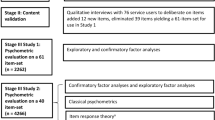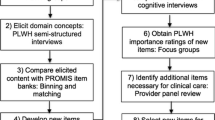Abstract
Purpose
Nonspecific factors that accompany healthcare treatments, such as patients’ attitudes and expectations, are important parts of the experience of care and can influence outcomes. However, no precise, concise, and generalizable instruments to measure these factors exist. We report on the development and calibration of new item banks, titled the Healing Encounters and Attitudes Lists (HEAL), that assess nonspecific factors across a broad range of treatments and conditions.
Methods
The instrument development methodology of the Patient-Reported Outcomes Measurement Information System (PROMIS®) was used. Patient focus groups and clinician interviews informed our HEAL conceptual model. Literature searches of eight databases yielded over 500 instruments and resulted in an initial item pool of several thousand items. After qualitative item analysis, including cognitive interviewing, 296 items were included in field testing. The calibration sample included 1657 respondents, 1400 obtained through an Internet panel and 257 from conventional and integrative medicine clinics. Following exploratory and confirmatory factor analyses, the HEAL item banks were calibrated using item response theory.
Results
The final HEAL item banks were Patient–Provider Connection (57 items), Healthcare Environment (25 items), Treatment Expectancy (27 items), Positive Outlook (27 items), and Spirituality (26 items). Short forms were also developed from each item bank. A six-item short form, Attitudes toward Complementary and Alternative Medicine (CAM), was also created.
Conclusions
HEAL item banks provided substantial information across a broad range of each construct. HEAL item banks showed initial evidence of predictive and concurrent validity, suggesting that they are suitable for measuring nonspecific factors in treatment.


Similar content being viewed by others
References
Berwick, D. M., Nolan, T. W., & Whittington, J. (2008). The triple aim: Care, health, and cost. Health Affairs, 27(3), 759–769.
National Center for Complementary and Alternative Medicine Third Strategic Plan 2011–2015. Exploring the science of complementary and alternative medicine 2011. http://nccam.nih.gov/sites/nccam.nih.gov/files/about/plans/2011/NCCAM_SP_508.pdf.
Enck, P., Benedetti, F., & Schedlowski, M. (2008). New insights into the placebo and nocebo responses. Neuron, 59(2), 195–206.
Benedetti, F., Amanzio, M., Benedetti, F., & Amanzio, M. (2011). The placebo response: how words and rituals change the patient’s brain. Patient Education and Counseling, 84(3), 413–419.
Kelley, J. M., Kraft-Todd, G., Schapira, L., Kossowsky, J., & Riess, H. (2014). The influence of the patient–clinician relationship on healthcare outcomes: A systematic review and meta-analysis of randomized controlled trials. PLoS One, 9(4), e94207.
Kaptchuk, T. J., Kelley, J. M., Conboy, L. A., Davis, R. B., Kerr, C. E., Jacobson, E. E., et al. (2008). Components of placebo effect: randomised controlled trial in patients with irritable bowel syndrome. BMJ, 336(7651), 999–1003.
Rakel, D., Barrett, B., Zhang, Z., Hoeft, T., Chewning, B., Marchand, L., et al. (2011). Perception of empathy in the therapeutic encounter: Effects on the common cold. Patient Education and Counseling, 85(3), 390–397.
Diederich, N. J., & Goetz, C. G. (2008). The placebo treatments in neurosciences: New insights from clinical and neuroimaging studies. Neurology, 71(9), 677–684.
Grenfell, R. F., Briggs, A. H., & Holland, W. C. (1961). A double-blind study of the treatment of hypertension. JAMA, 176(2), 124–130.
Wasan, A. D., Kong, J., Pham, L. D., Kaptchuk, T. J., Edwards, R., & Gollub, R. L. (2010). The impact of placebo, psychopathology, and expectations on the response to acupuncture needling in patients with chronic low back pain. Journal of Pain, 11(6), 555–563.
Vase, L., Baram, S., Takakura, N., Yajima, H., Takayama, M., Kaptchuk, T. J., et al. (2013). Specifying the nonspecific components of acupuncture analgesia. Pain, 154(9), 1659–1667.
Kalauokalani, D., Cherkin, D. C., Sherman, K. J., Koepsell, T. D., & Deyo, R. A. (2001). Lessons from a trial of acupuncture and massage for low back pain. Spine, 26, 1418–1424.
Kaptchuk, T. J., Friedlander, E., Kelley, J. M., Sanchex, M. N., Kokkotou, E., Singer, J. P., et al. (2010). Placebos without deception: A randomized controlled trial in irritable bowel syndrome. PLoS One, 5(10), 1–7.
Barrett, B., Muller, D., Rakel, D., Rabago, D., Marchand, L., & Scheder, J. C. (2006). Placebo, meaning, and health. Perspectives in Biology and Medicine, 49(2), 178–198.
Walach, H., & Jonas, W. B. (2004). Placebo research: the evidence base for harnessing self-healing capacities. Journal of Alternative and Complementary Medicine, 10(Suppl 1), S103–S112.
Price, D. D., Finniss, D. G., & Benedetti, F. (2008). A comprehensive review of the placebo effect: recent advances and current thought. Annual Review of Psychology, 59, 565–590.
Hyland, M. E., Geraghty, A. W. A., Joy, O. E. T., & Turner, S. I. (2006). Spirituality predicts outcome independently of expectancy following flower essence self-treatment. Journal of Psychosomatic Research, 60, 53–58.
Meissner, K., Kohls, N., & Colloca, L. (2011). Introduction to placebo effects in medicine: mechanisms and clinical implications. Philosophical Transactions of the Royal Society of London-Series B: Biological Sciences, 366, 1783–1789.
Cella, D., Yount, S., Rothrock, N., Gershon, R., Cook, K., Reeve, B., et al. (2007). The Patient-Reported Outcomes Measurement Information System (PROMIS): progress of an NIH Roadmap cooperative group during its first two years. Medical Care, 45(5 Suppl 1), S3–S11.
Cella, D., Gershon, R., Lai, J. S., & Choi, S. (2007). The future of outcomes measurement: item banking, tailored short-forms, and computerized adaptive assessment. Quality of Life Research, 16(Suppl 1), 133–141.
Cella, D., Riley, W., Stone, A., Rothrock, N., Reeve, B., Yount, S., et al. (2010). The Patient-Reported Outcomes Measurement Information System (PROMIS) developed and tested its first wave of adult self-reported health outcome item banks: 2005–2008. Journal of Clinical Epidemiology, 63(11), 1179–1194.
DeWalt, D. A., Rothrock, N., Yount, S., Stone, A. A., & PROMIS Cooperative Group. (2007). Evaluation of item candidates: the PROMIS qualitative item review. Medical Care, 45(5 Suppl 1), S12–S21.
Reeve, B. B., Hays, R. D., Bjorner, J. B., Cook, K. F., Crane, P. K., Teresi, J. A., et al. (2007). Psychometric evaluation and calibration of health-related quality of life item banks: plans for the Patient-Reported Outcomes Measurement Information System (PROMIS). Medical Care, 45(5 Suppl 1), S22–S31.
Klem, M. L., Saghafi, E., Abromitis, R., Stover, A., Dew, M. A., & Pilkonis, P. (2009). Building PROMIS item banks: Librarians as co-investigators. Quality of Life Research, 18, 881–888.
Greco, C. M., Glick R. M., Morone N. E., & Schneider M. J. (2013) Addressing the “It is just placebo” pitfall in CAM: Methodology of a project to develop patient-reported measures of nonspecific factors in healing. Evidence-Based Complementary and Alternative Medicine, 2013, 613797. doi:10.1155/2013/613797.
Guy, W. (1976). Clinical global impressions: ECDEU assessment manual for psychopharmacology (pp. 218–222). Rockville, MD: National Institute of Mental Health.
Muthen, L. K., & Multhen, B. O. (2007). Mplus user’s guide (4th ed.). Mullen & Mullen: Los Angeles, CA.
Thissen, D., Chen, W.-H., & Bock, R. D. (2003). Multilog (version 7). Lincolnwood, IL: Scientific Software International.
Orlando, M., & Thissen, D. (2003). Further investigation of the performance of the S-X2: An item fit index for use with dichotomous item response theory models. Applied Psychological Measurement, 27, 289–298.
Safran, D. G., Karp, M., Coltin, K., Chang, H., Li, A., Ogren, J., & Rogers, W. H. (2006). Measuring patients’ experiences with individual primary care physicians. Results of a statewide demonstration project. Journal of General Internal Medicine, 21(1), 13–21.
Devilly, G. J., & Borkovec, T. D. (2000). Psychometric properties of the credibility/expectancy questionnaire. Journal of Behavior Therapy and Experimental Psychiatry, 31(2), 73–86.
Choi, S. W. (2009). Firestar: Computerized adaptive testing (CAT) simulation for polytomous IRT models. Applied Psychological Measurement, 33, 644.
Choi, S. W., Reise, S. P., Pilkonis, P. A., Hays, R. D., & Cella, D. (2010). Efficiency of static and computer adaptive short forms compared to full length measures of depressive symptoms. Quality of Life Research, 19, 125–135.
Institute for Healthcare Improvement. www.ihi.org.
Acknowledgments
The study was funded by the National Institutes of Health, National Center for Complementary and Integrative Health (NCCIH R01 AT006453). The NCCIH had no role in designing and conducting the study, data collection, management, and analysis, and interpretation of the data, or preparation, review, and approval of the manuscript.
Funding
This study was funded by the National Institutes of Health, National Center for Complementary and Integrative Health (R01 AT006453), USA.
Author information
Authors and Affiliations
Corresponding author
Ethics declarations
Conflict of interest
All authors declare that they have no conflicts of interests regarding the study.
Ethical approval
All procedures performed were in accordance with the ethical standards of the institutional research committee and with the 1964 Helsinki declaration and its later amendments or comparable ethical standards. This study was approved by the Institutional Review Board of the University of Pittsburgh.
Informed consent
Informed consent was obtained from all focus group participants, cognitive interview participants, and clinical calibration participants.
Electronic supplementary material
Below is the link to the electronic supplementary material.
Rights and permissions
About this article
Cite this article
Greco, C.M., Yu, L., Johnston, K.L. et al. Measuring nonspecific factors in treatment: item banks that assess the healthcare experience and attitudes from the patient’s perspective. Qual Life Res 25, 1625–1634 (2016). https://doi.org/10.1007/s11136-015-1178-1
Accepted:
Published:
Issue Date:
DOI: https://doi.org/10.1007/s11136-015-1178-1
Keywords
- Nonspecific contextual factors in treatment
- Placebo measurement
- Treatment expectations
- Patient–provider relationship
- Perceptions of the Healthcare Environment
- Patient experience of care
- Patient-reported measures
- PROMIS instrument development methodology
- Positive Outlook
- Spirituality
- Attitude toward complementary medicine




